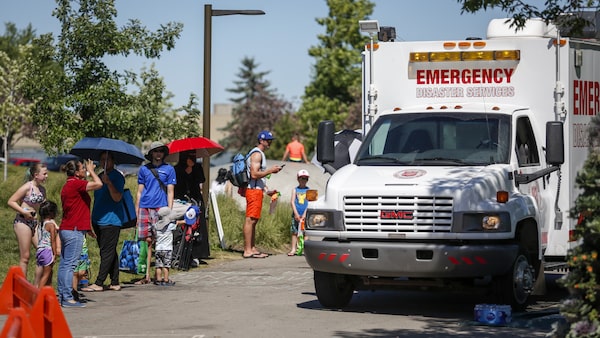A cyclist cools off at a misting station on East Hastings street in Vancouver on July 26.JENNIFER GAUTHIER/Reuters
As extreme heat warnings blanketed Western Canada with temperatures surpassing 40 C in some areas, officials urged precaution and cooling centres opened their doors in parts of British Columbia.
More than 60 Environment Canada heat warnings were active Thursday, covering most of Alberta and B.C., in addition to a small part of central Saskatchewan. The agency warned that temperatures, which were expected to be above 30 in many areas and above 40 in B.C.’s Interior, could result in serious illnesses, such as stroke.
Just last summer, a heat wave in B.C. killed 619 people and underscored the growing risk of severe weather as a result of climate change and revealed gaps in the province’s warning systems and emergency preparedness.
Globe Climate: Brutal summer heat waves forecast the need to better prepare for a hotter future
Armel Castellan, a Victoria-based meteorologist with Environment Canada, said this week’s extreme heat poses a significant risk to people’s health but has not reached the same intensity as what was seen during the “heat dome” last summer.
“We see an uptake of, on average, about 5 per cent extra mortality in the province when you have a heat warning for the regions affected,” Mr. Castellan s
aid. “When it’s an extreme heat emergency, then that number is at a 20-per-cent increase in mortality or more where we start to see many hundreds of calls to 911 for heat-related needs and well over 100 people dying per day.”
B.C. government spokesperson Aimée Harper said in a statement that the province is not anticipating an extreme heat emergency at this time, but is prepared to issue an alert to mobile phones if the threshold is met. This requires daytime maximum temperatures to substantively increase day over day for three or more consecutive days and a “very high increase in public health risk.”
More than a dozen daily temperature records broken in B.C. as heat warnings remain in place
Single-day maximum temperature records have been broken in both provinces, including some that have been held for more than 80 years. Four areas in Alberta and 10 in British Columbia surpassed historic highs on Wednesday, according to an Environment Canada report. The southern B.C. village of Lytton, which was mostly destroyed by a fire during last year’s heat wave, reached 42 C, surpassing the 1939 record of 40 C for that day.
Many cities in B.C. opened cooling centres, with some providing other resources such as bottled water and food.

A Salvation Army EMS vehicle is setup as a cooling station in Calgary on June 30, 2021.Jeff McIntosh/The Canadian Press
In Kamloops, where 17 people died during last year’s heat wave, the city opened its arena to offer people shelter from the heat. The building has the capacity to hold thousands of people.
Linda Stride, the city’s recreation, health and wellness supervisor, said their cooling centre has books, games, cards and puzzles, as well as snacks from the local food bank. There is also space set aside for people with pets. Kamloops has two more cooling centres that are expected to open in August.
In the village of Ashcroft, a cooling centre that can accommodate 30 to 50 people is open to the public from 8 a.m. to 8 p.m. until at least Friday.
How you (and your home) can stay cool in a heat wave
Numerous Vancouver community centres and library branches are being used as cooling centres. In a statement, the city said if Environment Canada declares an extreme heat emergency, it will activate its Level 2 response, which includes overnight operations in neighbourhoods more vulnerable to heat.
The city, in collaboration with Vancouver Coastal Health, is also providing “cool kits” to people at increased risk, such as isolated seniors; people with chronic, underlying health conditions; and lower-income residents.
Interior Health said 18 people have visited emergency departments in the past week for heat-related issues, compared with seven the week before, while on Vancouver Island five people went to emergency departments this week for heat.
In Calgary, Chaz Smith, founder of outreach organization BeTheChangeYYC, said many people living on the streets are suffering heat fatigue. So far, outreach volunteers have been able to remedy most cases with water and cold packs but with extreme temperatures expected to persist in coming days, Mr. Smith is worried more serious illnesses, and even death, could result.
“I’m really concerned for the people sleeping outside all night and all day,” he said. “Ambulances are not coming very quickly these days. We’re waiting 20 to 30 minutes depending, so during that period of time at least we’re able to do something rather than nothing.”
Over the past nine days in Calgary, EMS said it has responded to 12 heat-related calls, doubling the total seen during the same time period last year. In Edmonton, 14 incidents have been recorded compared with just two in 2021.
Kyle Fougère, an Edmonton-based meteorologist with Environment Canada, said some parts of Alberta will see reduced temperatures in coming days, but in southern Alberta the intense heat will linger until at least early next week when thunderstorms are expected.
Alberta’s Emergency Management Agency and Health Ministry did not respond to requests for comment on supports available to those most affected by the extreme heat.
We have a weekly Western Canada newsletter written by our B.C. and Alberta bureau chiefs, providing a comprehensive package of the news you need to know about the region and its place in the issues facing Canada. Sign up today.
 Alanna Smith
Alanna Smith Xiao Xu
Xiao Xu